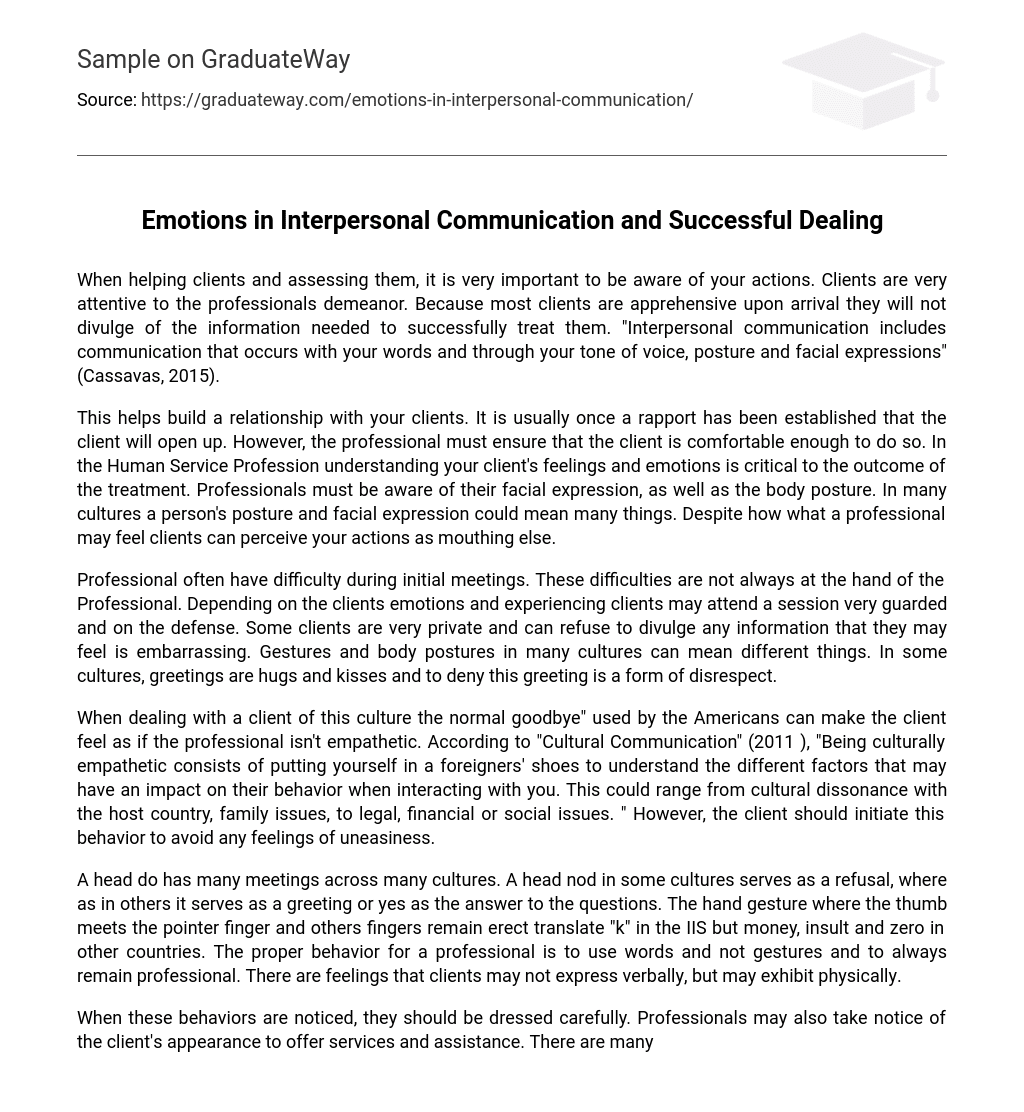When helping clients and assessing them, it is very important to be aware of your actions. Clients are very attentive to the professionals demeanor. Because most clients are apprehensive upon arrival they will not divulge of the information needed to successfully treat them. “Interpersonal communication includes communication that occurs with your words and through your tone of voice, posture and facial expressions” (Cassavas, 2015).
This helps build a relationship with your clients. It is usually once a rapport has been established that the client will open up. However, the professional must ensure that the client is comfortable enough to do so. In the Human Service Profession understanding your client’s feelings and emotions is critical to the outcome of the treatment. Professionals must be aware of their facial expression, as well as the body posture. In many cultures a person’s posture and facial expression could mean many things. Despite how what a professional may feel clients can perceive your actions as mouthing else.
Professional often have difficulty during initial meetings. These difficulties are not always at the hand of the Professional. Depending on the clients emotions and experiencing clients may attend a session very guarded and on the defense. Some clients are very private and can refuse to divulge any information that they may feel is embarrassing. Gestures and body postures in many cultures can mean different things. In some cultures, greetings are hugs and kisses and to deny this greeting is a form of disrespect.
When dealing with a client of this culture the normal goodbye” used by the Americans can make the client feel as if the professional isn’t empathetic. According to “Cultural Communication” (2011 ), “Being culturally empathetic consists of putting yourself in a foreigners’ shoes to understand the different factors that may have an impact on their behavior when interacting with you. This could range from cultural dissonance with the host country, family issues, to legal, financial or social issues. ” However, the client should initiate this behavior to avoid any feelings of uneasiness.
A head do has many meetings across many cultures. A head nod in some cultures serves as a refusal, where as in others it serves as a greeting or yes as the answer to the questions. The hand gesture where the thumb meets the pointer finger and others fingers remain erect translate “k” in the IIS but money, insult and zero in other countries. The proper behavior for a professional is to use words and not gestures and to always remain professional. There are feelings that clients may not express verbally, but may exhibit physically.
When these behaviors are noticed, they should be dressed carefully. Professionals may also take notice of the client’s appearance to offer services and assistance. There are many things to take into effect when initially meeting and treating a client. The professionals purpose is to help the client. The most important thing to remember is the atmosphere and the professionals’ behavior and appearance Sets the scene and allows comfort and trust to be established within communication between the helper and the client An emotional connection between client and the professional is necessary.
This injection indicates that the helper shows empathy. Sympathy isn’t what client is looking for. They do not want the helper to feel sorry for them but to understand them enough to help them. The client’s professional and social skills will ensure a sense of security for the clients. Ultimately, the beginning of every session, should begin with an assessment with the Professional asking questions to determine the tone or the mood of the client, such as “You look great today, how do you feel? ” or “What have you learned from these sessions? ” “Do you feel that they are lawful? Reflection helps the professional to understand if the techniques being used are effective for the client’s situation, it also gives the client the opportunity to notice and record the differences in their situation and to remember what tools helped. The helper is to provide clients with effective tools and skills to continue to progress through their problems, having discussions with the clients will indicate the methods used and the reactions and outcomes. A professional must always remember to consider the client in everything that they do.
Helping the client to effectively manage their emotions and express themselves when in a helping environment and setting, as well as providing a sense of security are all characteristics of a successful client helper relationship.





